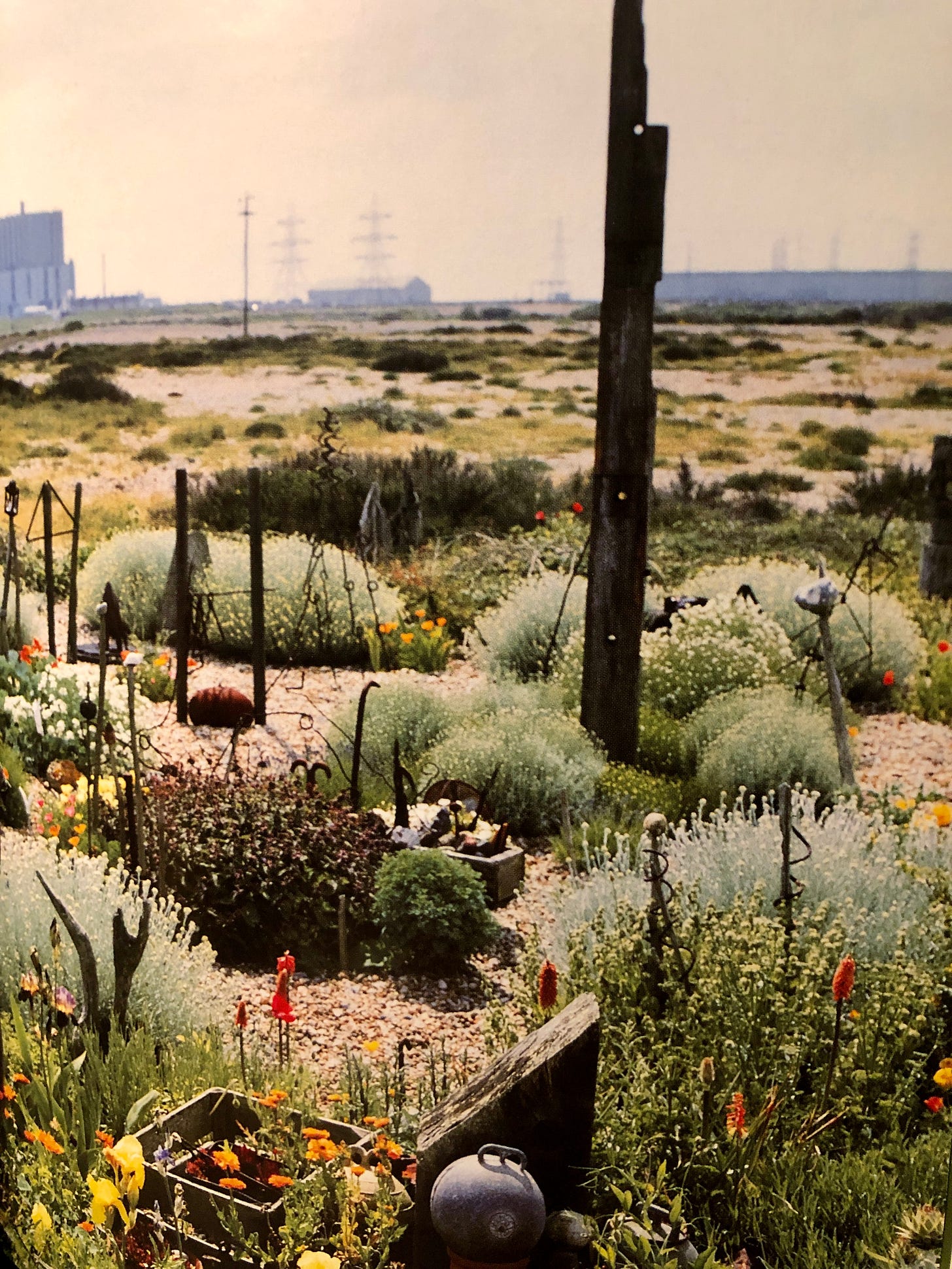Garden as metaphor
The persistence of nature at home and in the studio, Derek Jarman on my mind.
Gardening idiot
I’m a gardening idiot, but I love to learn. My excuse is that I grew up in a rental without a yard of my own. Although New Jersey is the Garden State, famous for tomatoes, I hung out in a mostly paved urban environment, playing badminton in the parking lot down the road with a speed bump as makeshift net. My single-minded mission was getting to art school and moving to New York to live among even more concrete. I was totally disinterested in and disconnected from the natural world.
At this point, I’ve spent half my life on the east coast and half on the west, in the most expensive cities where culture is rich, but I am not. Only in the last two years have I found a home that I hope to make last, and with that, permission to plant seeds that will take time.
The Pacific Northwest is paradise for gardeners. All the rain supports robust growth, it’s pretty temperate compared to most of the U.S., and summers are secretly glorious. Budget constraints and what I now recognize as good fortune have landed my family and me on a wild, “unimproved” unpaved street, walkable to all the city conveniences yet tucked away on a quiet block, where people commandeer the road with their plants, chickens, and goats. It’s a weird, wonderful mix.
Tending
What does all this gardening talk have to do with your art newsletter, you may be asking? They have tending and cultivating in common.
I’m a big fan of Beth Pickens, and one of the enduring lessons she’s taught me is the importance of tending. Sometimes that is the practice, in a seemingly dormant time. Growing slowly, unseen, under the surface. Taking care. I view my studio practice as the accumulation of small gestures that add up to a work (hopefully) greater than the sum of its parts, containing what is otherwise inarticulable for me in any medium other than visually through form. The blurry visions and imaginings slowly build in bits and layers, fragments fitting together like a puzzle, until a new landscape emerges.
My front yard was barren, a blank slate, liberating. I’ve spent countless hours over the last year pulling thousands of dandelions and weeds, at times possessed, finding trash and little shells from when the land I now inhabit was a riverbed. Thinking about what I owe it to repair, an apology to the bees, wildlife, and previous inhabitants. Collecting cardboard and free wood chips from ChipDrop, heeding the kind advice of gardener neighbors, dreaming and planning for the future, even when it felt far off and impossible. Finding solace in the work.
I stumbled upon an article about Derek Jarman’s garden in Inverness. The brilliant Olivia Laing also wrote about him in Funny Weather: Art in an Emergency. Suddenly Derek was everywhere.

Derek Jarman’s Garden
Known primarily as a filmmaker, Jarman had been gardening since he was a child. One of his most enduring artworks is the garden he made in the 90’s on a piece of harsh land in Dungeness, Kent on the coast of England, where the salt spray burns the plants, the rocky shingle is inhospitable, and a nuclear power plant buzzes in the distance. He added poetry to the side of his fisherman’s cabin, Prospect Cottage, and constructed enigmatic sculptures throughout the garden made from rusted metal found in the surrounding landscape, some of it dating from World War II. He did not believe in borders or fences and gloriously disdained lawns.

Jarman was diagnosed with HIV in 1986, which was a death sentence not to mention highly stigmatized at a time before drugs and treatments were developed. His garden was an act of resistance in the face of certain death, a gesture of hope, gradually and relentlessly created on a shoestring budget. He did not do it alone. I find much relatability and sustenance in his story. How strange to think I was losing my own father at the same time Derek was doing this work, and how much I would have loved to know about this place, about other possibilities to live and exist, to find peace with what you can’t control.

Immersing myself in this story thirty years later fills part of an empty space inside me, made less lonely through experiencing his art and writings.
The cultivating, investing, and persisting in a creative practice is the true project for the long run. We try to change the landscape; it shapes us. It can’t really be tamed. Some plants wither, die, and return to the soil. Others thrive. Sometimes we don’t know why, and nature doesn’t care. It’s forgiving, inviting us to begin again. It’s never too late.
Looking at, listening to, and reading
Prospect Cottage, by Howard Sooley
A new version of Can’t Hardly Wait, with cellos. The whole reissue of Tim (Let it Bleed Edition) <3
Derek Jarman’s Garden and Modern Nature.
Thanks for being here -
Val
⋰ Website
⋰ Email : val@valbritton.com (or respond to this email)










I enjoy reading your thoughts connecting gardening and creative process and life. The mysteries around why some things wither and others thrive. Gardening as medicine. I want to get out there and prune now. Thanks for sharing, Val.